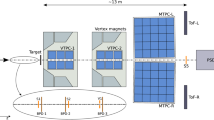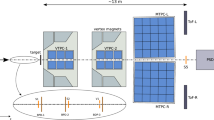Abstract
An investigation of inclusivepp→π−+⋯ in terms of the covariant Boltzmann factor (BF) including the chemical potential μ indicates a) that the temperatureT increases less rapidly than expected from Stefan's law, b) that a scaling property holds for the fibreball velocity of π− secondaries, leading to a multiplicity law like ∼E 1/2cm at high energy, and c) that μπ is related to the quark mass: μπ=2m q −m π the quark massm q determined by\(T_{\pi ^ - } \) at\(\bar pp\) threshold beingm q =3Tπ≃330 MeV. Because ofthreshold effects \(T_{\bar p}< T_{\pi ^ - } \), whereas\({{\mu _p } \mathord{\left/ {\vphantom {{\mu _p } {\mu _{\pi ^ - } }}} \right. \kern-\nulldelimiterspace} {\mu _{\pi ^ - } }} \simeq {3 \mathord{\left/ {\vphantom {3 2}} \right. \kern-\nulldelimiterspace} 2}\) as expected from the quark contents of\(\bar p\) and π. The antinuclei\(\bar d\) and\({{\bar t} \mathord{\left/ {\vphantom {{\bar t} {\overline {He^3 } }}} \right. \kern-\nulldelimiterspace} {\overline {He^3 } }}\) observed inpp events are formed by coalescence of\(\bar p\) and\(\bar n\) produced in thepp collision. Semi-empirical formulae are proposed to estimate multiplicities of π−,\(\bar p\) and antinuclei.
Similar content being viewed by others
References
T.T. Chou, Chen-Ning Yang, E. Yen: Phys. Rev. Lett. 54 (1985) 510
T.T. Chou, Chen-Ning Yang Phys. Rev. D32 (1985) 1692
— Phys. Rev. Lett. 55 (1985) 1359
T.F. Hoang, B. Cork: Z. Phys. C-Particles and Fields 38 (1988) 608; T.F. Hoang: Phys. Rev. D, in press
E. Fermi: Prog. Theor. Phys. 5 (1950) 570;
— Phys. Rev. 81 (1951) 683
L.D. Landau: Akad. Nauk SSSR, sr. fiz. 17 (1953) 51
R. Hagedorn: Nuovo Cimento Suppl. 3 (1965) 167; Nuovo Cimento 56A (1968) 1027; Rev. Lett. Nuovo Cimento, 6 (1982) N10
See. e.g. S. Weinberg: Gravitation and cosmology p. 530: New York: Wiley 1972
T.F. Hoang Nucl. Phys. B38 (1972) 333
— Phys. Rev. D12 (1975) 296
ibid17 (1978) 927
ibid24 (1981) 1406
Except onenp experiment at 3 GeV/c, W.B. Fowler et al.: Phys. Rev. 95 (1954) 1026; we use the following 221-1 data: (a) 6.92 GeV/c, S. Danieli et al.: Nucl. Phys. B27 (1971) 157; (b) 10 GeV/c, P. Almeida et al.: Phys. Rev. 174 (1968) 1638; (c) 12 GeV/c, J.L. Day et al.: Phys. Rev. Lett. 18 (1969) 1218; (d) 10, 88, 18, 21.1 and 24.1 GeV/c, D.B. Smith et al.: Phys. Rev. Lett. 23 (1968) 1064; (e) 19.2 GeV/c, H. Bøgglid et al.: Nucl. Phys. B27 (1971) 1; (f) 28 GeV/c, R.S. Panvani et al.: Phys. Lett., 38B (1972) 55; (g) 69 GeV/c, V.V. Ammosov et al.: Phys. Lett. 42B (1972) 519; F. Binon et al.: ibid. Phys. Lett 30B (1969) 506 (h) 100 GeV/c, J.W. Chapman et al.: Phys. Lett. 47B (1973) 465; (i) 205 GeV/c, S. Barish et al.: Phys. Rev. D9 (1974) 2689; G. Charlton et al.: Phys. Rev. Lett 30 (1973) 594 (j) 303 GeV/c, P.T Dao et al.: Phys. Rev. Lett. 39 (1972) 1627; (k)vs=43, 60 GeV, B. Alpan et al.: Nucl. Phys. B100, 237 (1975); A. Breakstone et al.: Phys. Rev D30 (1984) 528
UA1 Coll. G. Arnisson et al.: Phys. Lett. 118B (1982) 167
We use the data compiled by the Bologna Group, C. Albini et al.: Nuovo Cimento 101A (1976) and assume for π− multiplicityn −=(n ch−1)/2
UA5 Coll., G.I. Alner et al.: Phys. Lett. 160B (1985) 193, 199
Bologna Group M. Antimucci et al.: Nuovo Cimento 6 (1973) 121;
— A.M. Rossi et al.: Nucl. Phys. 84B (1975) 269
Bologna-Saclay-LAPP Coll. A. Bussieie, et al.: Nucl. Phys. 174 (1980) 1
Bologna-Padova-Saclay Coll., N. Bozzoli et al.: Nucl. Phys. B144 (1978) 317
Serpukhov-Yu.M. Antipov et al.: Nucl. Phys. 31B (1971) 235;
— Phys. Lett. 34B (1971) 164
Bologna-Padova-LAPP Coll., W. Bozzoli et al.: Nucl. Phys. B 144 (1978) 317 The parameters of fit with (18) arefuc=1,p=0.31±0.02 andfuc=1/A!,p=0.77±0.09, assumingT=150MeV
We use theA-dependence ofn − ofp-nucleus data of JINR experiment: N.K. Bish et al.: J. Nucl. Phys. 30 (1979) 824.
See e.g. M. Deritchmann et al.: Nucl. Phys. B70 (1974) 189
See, e.g., the two-temperature model of C.K. Chou et al.: Phys. Rev. D29 (1984) 2127. They assume an exponential law for eachT:A“e −p⊥/T. According to their values for the experiment of 221-3 Collider [10], namelyT 1-2774 MeV,T 2=664 MeV andA 1/A 2=500, the averageP ⊥ should be ∼T 2, compared to 424±1 MeV/c, indicating a non-negligible transverse velocitya≃0.36 of the fireball
Author information
Authors and Affiliations
Additional information
This work was supported by the Director, Office of Energy Research, Division of Nuclear Physics, Office of High Energy and Nuclear Physics, of the U.S. Department of Energy under Contract No. DE-AC03-76SF00098, and by NASA under Grant NGR05-003-513
Rights and permissions
About this article
Cite this article
Hoang, T.F., Crawford, H.J. Characteristics of π−,\(\bar p\), and antinuclei frompp collisions. Z. Phys. C - Particles and Fields 43, 215–221 (1989). https://doi.org/10.1007/BF01588208
Received:
Issue Date:
DOI: https://doi.org/10.1007/BF01588208




